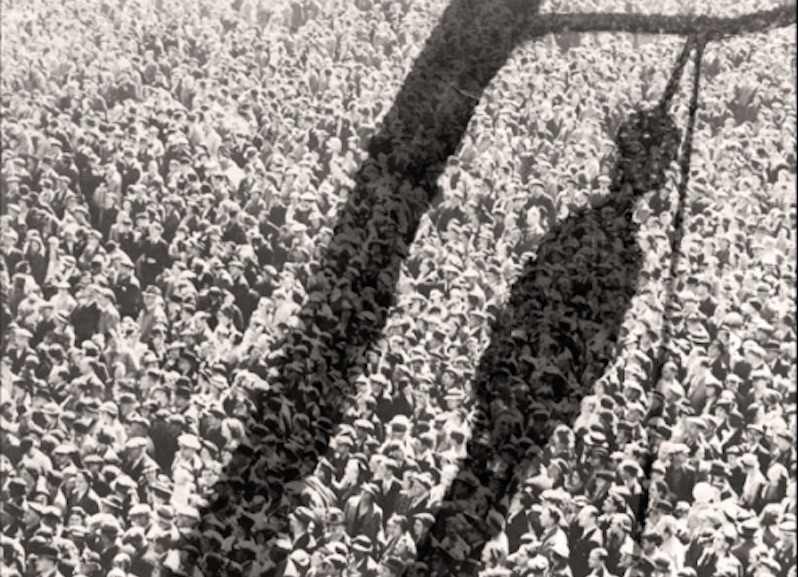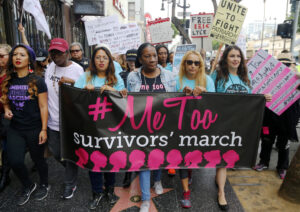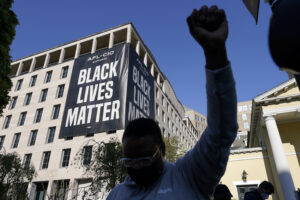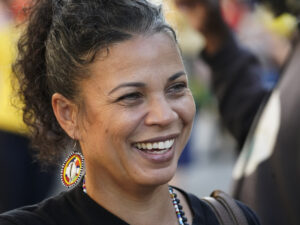A ‘Black Lives Matter’ Activist Faces Hard Time Under a Law Meant for Racist Killers
As Americans forget more and more of our nation's troubling past, a misguided California prosecutor's case against a young protester is turning the meaning of "lynching" inside out.As Americans continue to forget our troubling past, the prosecution of a protester in California is turning the meaning of "lynching" inside out. A photomontage from the Library of Congress' NAACP records.
A photomontage from the Library of Congress' NAACP records.
No one ever told me that there were ghosts hidden amid the tall pines and mossy oaks of Slidell, the small Louisiana city where I grew up. But somehow, even as a boy in the 1980s and ’90s, I always felt the presence of those spirits floating on the sweet, magnolia-scented breeze that Billie Holiday once sang about so poignantly. I was a grown man, however, before I learned the story of one those ghosts — known only as Romeo, a victim of a brutal murder at the hands of a bloodthirsty mob.
My grandmother mentioned him to me one day, in a very offhanded way, saying that when she was 12, she had overheard her father talking with other relatives about Romeo. Her father — my great-grandfather — was only a year old when the murder had occurred, so even older folks had passed the story to him:
Romeo, a black man, had been accused of drawing a gun on another man during a fight. When officers had later tried to question him, a deadly shootout had ensued, resulting in the death of a local marshal. Though Romeo initially escaped arrest, he was injured in the gunfire and, as he ran from the scene, he left a trail of blood that made him relatively easy for the authorities to find and capture.
A hundred of Slidell’s white citizens quickly amassed, according to news accounts from the time, forcibly taking him from police custody. They then placed a rope around his neck, tied him to the back of a car, and dragged him through the city streets. As was the custom, the town coroner recorded the cause of death as “strangulation at the hands of unknown parties.” To my knowledge, no investigation was conducted, and no charges were filed.
In many ways, it was a typical lynching, unremarkable when compared, for example, to that of Mary Turner, a pregnant Georgia woman who was killed in 1918 during a sadistic, five-day frenzy that, by some accounts, left at least 13 people dead. Turner — who had angered mob members by threatening to have them arrested for killing her husband — was abducted, hung upside-down from a tree, doused with gasoline and set ablaze. Her unborn child, still alive, was then cut from her womb and stomped to death before Turner’s mutilated body was riddled with bullets. Again, none of the perpetrators were punished.
Romeo’s story has now been passed down for five generations in my family. For me and my kinfolk, its importance lies not in its uniqueness or overarching significance but in the fact that Romeo’s blood has been spilled and smeared on ground that we have walked on, in the very place that has nurtured us and made us who we are. Speaking for myself, the retellings of his story make similar events from the distant past seem a little more real, and a little more frightening.
For Americans, Romeo’s murder may spark the memory of James Byrd Jr., another black man, who was similarly dragged to death by white supremacists in Texas in 1998, some 84 years later. But going back much further than that, many of us lack substantial knowledge of our nation’s past — as study after study has shown.
In the year 2015 — just over a century after Romeo’s tragic end — the lynching era has been so thoroughly forgotten by most of us that a young black woman is now facing a four-year prison term in a case that turns the meaning of the word “lynching” inside out.
On Jan. 18, a pro-police rally was being held near the Capitol building in Sacramento, Calif., and Maile Hampton, a 20-year-old activist, was attending a counter-rally. She and others were raising their voices against killings, by both police and vigilantes, of unarmed black people — such as Michael Brown in Ferguson, Mo., and Eric Garner in New York last year. (It’s an issue that some might argue is the contemporary analogy to lynching.)
As Hampton’s group marched on the Capitol Mall, officers ordered it to move onto the sidewalk, and those marchers who did not immediately comply were arrested. In a YouTube video of the incident, some protesters — and Hampton is allegedly one of these — appear to try to pull their comrades out of police custody, a felony that the California penal code defines as “lynching.”
On Feb. 23, more than a month after the protest, Hampton was arrested at her home, saddled with both “lynching” and obstruction-of-justice charges. She spent the night in jail before being released on $100,000 bail, and she is scheduled to be arraigned in Sacramento Superior Court on April 9. Her defense lawyer, Linda Parisi, has advised her not to speak to reporters.
Understandably, Hampton’s case has caused both bewilderment and outrage among activists in Northern California and elsewhere. ANSWER Coalition — an anti-war, anti-racist organization — has started an online petition demanding that Sacramento’s district attorney, Anne Marie Schubert, drop the charges.
Schubert and the police in California’s capital are apparently unaware of the irony of prosecuting a black social-justice activist under a 1933 law meant to protect people of color from the kind of racist vigilantes that kidnapped and killed Romeo in my hometown.
The statute, Section 405a of the state’s penal code, has been used to prosecute defendants for interfering with arrests since at least 1971. But it is unclear if any previous prosecution has involved someone who was actively protesting the killing of unarmed blacks, the very thing that the statute was originally designed to deter.Sacramento’s mayor, Kevin Johnson, has made a point to criticize Hampton for her alleged crime. In a Twitter post last month, he wrote: “It is never ok for someone to interfere with the police, or try to remove someone who is in police custody.” He did admit, however, that he was “shocked” to learn at a recent City Council meeting about his state’s strange definition of “lynching.”
Johnson now hopes to convince state lawmakers to change the statute’s wording.
“The word ‘lynching’ has a long and painful history in our nation,” he tweeted. “It’s time to remove its use in CA Law.”
The mayor has at least one legislator on his side: state Sen. Holly Mitchell, D-Los Angeles.
In a statement given to The Sacramento Bee, and later posted on her website, Mitchell wrote: “The fact that the term ‘lynching’ appears in California Penal Code in a manner contrary to what most citizens would define it is not just an anomaly; it is a racially loaded term that evokes strong reactions.”
“The current ‘lynching’ definition in code is an affront” to the thousands of lynching victims, she added.
But is changing the wording of the law really the solution?
It seems to me that such a change will simply allow the status quo to continue: Police can continue to harass protesters for walking off sidewalks; black people can continue to be targets of unwarranted and unpunished violence; and the general public can continue to be blissfully unaware of how these issues connect to the events of our past.
The one benefit to having the law in its current form is that Hampton’s case can now be used to open up discussion on the topic of lynching — about which we talk very little and know even less.
Here’s a brief overview: According to records compiled by the Tuskegee University Archive, more than 3,400 blacks were lynched in 44 states, including California, Illinois, Minnesota and New York, between 1882 and 1964. In contrast, a more recent study by the Equal Justice Initiative, a legal defense organization, looked only at 12 Southern states and found nearly 4,000 such murders were committed between 1877 and 1950. In any event, no matter whose count we believe, we can safely say that the number of victims was in the thousands.
But why? Why did these kinds of attacks happen to so many people?
One part of the answer is the outcome of the Civil War, which had brought the end of slavery and the rise of black civic leadership and political participation. It had also brought shame and despair to many white Americans, who had felt the sting of losing both a military clash and a way of life. Many had also lost property, friends and family in the war and were simply unwilling to also lose the privileged status that had given them a sense of identity for so long. Consequently, they began campaigns of racist terror and homicidal mania that swept the entire country — particularly the South — and did not end for nearly a century.
Mark Potok of the Southern Poverty Law Center, one of the nation’s leading experts on hate-based extremism, told me in an interview that lynching was a tool that whites used to enforce social control and to maintain dominance.
“I think of a lynching as a public murder that is a message,” he said. One such message, he added, could have been that black men should stay away from white women. “That’s part of its terrorist aspect. It’s a message to African-Americans in the community that if you cross any line, you will die in the most horrible way.”
(By the way, were you taught any of this in your high school or college history courses? I certainly wasn’t.)
The Ku Klux Klan was often an important force behind these campaigns of social control, but the group was not solely responsible, by any means. Entire communities of hundreds or thousands of whites — not only Klan members — would come out to participate in extrajudicial killings, which they treated at times as social occasions. Participants, smiling and fearing no punishment, posed for photographs with the hanging bodies of their victims. Sometimes the crowds included women and children, dressed in their Sunday best. And the victims — not always murder or rape suspects — could very well be innocent of any crime.
The black investigative journalist Ida B. Wells, who began documenting the horrors of lynching in the early 1890s, worked hard to try to dispel the perception that blacks were lynched primarily for sexual attacks on white women. In fact, her reports showed that blacks were commonly lynched for offenses like robbery, burglary, arson, rioting, making threats, quarreling with whites and even “race prejudice,” whatever that might have meant. In some cases, she wrote, “no reasons were given, the victims were lynched on general principles.”
By 1910, long before the end of the lynching era, the New York federal judge George C. Holt estimated that 300,000 white Americans had joined in carrying out lynching-style murders over the previous 40 years — and in the year he presented his claims, he said 165,000 of those murderers were still alive and unprosecuted.
That’s because law enforcement authorities were rarely willing to charge whites for lynching blacks. When they did charge whites, juries were rarely willing to convict. In one 1935 case in Chatham County, Tenn., five white defendants openly admitted to lynching a black victim, but the jury acquitted all of them at trial, prompting the judge to exclaim: “I am astounded at your verdict.”
Between 1899 and 1937, about 1,837 blacks were lynched, the Tuskegee records indicate. In that same period, there are 57 known convictions of whites for committing such crimes. That’s a conviction rate of approximately 3 percent for white-on-black lynchings.
To be fair, many brown, red, yellow and even white people were also lynched. The Tuskegee documents show that roughly 213 whites were lynched from 1899 to 1937, and that there were 62 reported convictions, for a ballpark conviction rate of 29 percent. The numbers are not exact because the final outcomes of many of the cases are absent from the Tuskegee records, but based on the available data, a jury was, roughly speaking, 10 times less likely to convict white defendants if a black person was the victim of a lynching-style attack than if a white one was — and that was only in the rare instance that charges were actually brought against the suspects.
In this context, the National Association for the Advancement of Colored People began calling for federal anti-lynching legislation as early as 1919, and, with the election of Franklin Delano Roosevelt in 1932, the organization was optimistic that such legislation could finally be passed. But — despite strident lobbying by black leaders, including Mary McLeod Bethune, a member of Roosevelt’s Black Cabinet of advisers, and even his own wife, Eleanor — the president feared that, if he backed a national anti-lynching law, Southern whites would never forgive him and that he would lose re-election.Thus, no federal law was ever passed to discourage this form of extrajudicial murder, and uncounted hordes of killers were never brought to justice.
In many ways, the lynching statistics cited above are comparable to what we see today in police-involved shootings — the kind that Hampton and fellow activists were demonstrating against in January. Though the data set is incomplete, what we do have shows that blacks are much more likely to be the victims of such shootings.
There are usually few consequences for the police officers involved. Last year, The Wall Street Journal reported that a study by a Bowling Green State University criminologist showed “41 officers in the U.S. were charged with either murder or manslaughter in connection with on-duty shootings over a seven-year period ending in 2011” while “over that same period, the Federal Bureau of Investigation reported 2,718 justified homicides by law enforcement, an incomplete count, according to experts.”
Based on those numbers — which are just rough estimates because some states, like New York, do not report such data — a maximum of 1.5 percent of officers were charged in on-duty shootings from 2005 to 2011.
“It’s very rare that an officer gets charged with a homicide offense resulting from their on-duty conduct even though people are killed on a fairly regular basis,” Philip Stinson, an assistant professor of criminal justice at Bowling Green, told the Journal. “Juries and trial court judges are seemingly reluctant to convict in criminal court an officer whose crimes rose out of an on-duty incident that occurred as part of their job.”
The Cato Institute, a libertarian think tank, studied 11,000 allegations of police misconduct between April 2009 and December 2010 and found that 33 percent of officers charged criminally were convicted. Meanwhile, the Journal reported that figures from the Bureau of Justice Statistics indicated a 66 percent conviction rate for the general public in 2009 for the country’s 75 largest counties. If those numbers are roughly generalizable, police officers are half as likely to be convicted on criminal charges as those in the general population — and that is only looking at the rare 1.5 percent of cases in which officers are actually charged. Sound familiar?
To a significant extent, lynching has made us who we are in the United States. Its legacy as a mechanism of social control can be seen clearly today in the case of Eric Garner, the 43-year-old Staten Island man who was killed on video last July when police arrested him.
Its legacy is evidenced in other ways as well. The staff of the Equal Justice Initiative (EJI) noted in a recent report, “Lynching in America: Confronting the Legacy of Racial Terror,” that fear of extrajudicial murders was a major reason for the Great Migration of millions of blacks out of the rural South starting in the early 20th century. “Thousands of people fled to the North and West out of fear of being lynched,” the researchers wrote. “Parents and spouses sent away loved ones who suddenly found themselves at risk of being lynched for a minor social transgression; they characterized these frantic, desperate escapes as surviving ‘near-lynchings.’ “
EJI also argues that the eventual decline in lynchings “relied heavily on the increased use of capital punishment imposed by court order following an often accelerated trial.”
Like the Civil War, lynching has shaped our identity as a people. Yet we have made no effort to keep alive the memory of the heinous practice. Almost none of the victims and sites of lynchings are memorialized, but Confederate heroes and even Klan leaders — such as Nathan Bedford Forrest and Edmund Pettus — are honored with plaques and monuments all across the nation (not only in the South).
Today, the legacy of lynching is being keenly felt by one young woman in Sacramento. With a little luck, the charges against her will be dropped. They certainly should be. But even if Maile Hampton is found guilty of impeding another protester’s arrest, she certainly does not deserve to spend years in prison.
Her prosecution gives us an opportunity to ponder the true meaning of “lynching,” and to remember and to grapple with this shameful and bloody aspect of our nation’s history. We may willfully forget the past, but doing so will never make the consequences of the past disappear.
Ignorance of history will only make it impossible for us to understand the events of our present day — from Ferguson, Mo., to Cleveland and from Staten Island, N.Y., to Madison, Wis. We must learn about that history for ourselves — no matter what color we may be — and we must share those sometimes-painful stories with future generations, as my grandmother shared Romeo’s story with me.
Bryan Stevenson, the Equal Justice Initiative’s executive director, hopes to start that learning process by building lynching memorials in Southern states. “We cannot heal the deep wounds inflicted during the era of racial terrorism until we tell the truth about it,” he said.
I think it’s a great idea, but I also think we should not wait around for Stevenson, or anyone else, to start installing plaques for us.
For starters, do you know the names and stories of any of the people of color who were lynched in your city or state? If you don’t, find out. It would be a good way to show that you value the thousands of lives killed in the name of white dominance. And once you know, share what you learn with others in your family and your neighborhood. Get a conversation started.
Let’s finally make amends with the ghosts of our country’s lynching era. Can’t you see them there — drifting along the busy streets of Memphis, through the grassy fields outside of Coatesville, and on the humid air above the swamps of Slidell? They have been waiting patiently for justice for far too long.
Channing Joseph, based in San Francisco, is one of Truthdig’s editors as well as an MTV News correspondent covering social justice issues. His stories have also been featured in The New York Times, The International Herald Tribune, The Atlantic, U.S. News & World Report, Entertainment Weekly, The Washington Post, People and BET as well as around the world in outlets like The Globe and Mail of Toronto and The New Zealand Herald.
Your support matters…Independent journalism is under threat and overshadowed by heavily funded mainstream media.
You can help level the playing field. Become a member.
Your tax-deductible contribution keeps us digging beneath the headlines to give you thought-provoking, investigative reporting and analysis that unearths what's really happening- without compromise.
Give today to support our courageous, independent journalists.








You need to be a supporter to comment.
There are currently no responses to this article.
Be the first to respond.